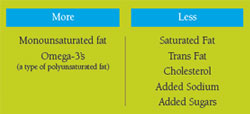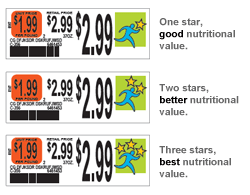The Guiding Stars program was developed to be an easy, at a glance tool to help you make healthier choices and find the most nutritious food in the store. Now, the panel of experts that developed the Guiding Stars program has created a special model to determine good, better and best choices within fats and oils.
With the addition of the fats and oils ratings, our Guiding Stars program now rates all foods that are a significant source of calories*, making it easier than ever to shop for nutritious choices.
Guiding Stars makes it simple to spot the most nutritious choices in every single category of food items by just following the stars. Look for the new stars on shelf tags in our oil and dairy areas.
For the answers to many frequently asked questions, visit our Guiding Stars FAQs page.
Striking the right balance
Fats and oils supply energy, help absorb some vitamins, and are important for a number of key body functions like protecting organs and supporting cell growth. According to the USDA Dietary Guidelines, adults should keep total fat intake to 20%-35% of total calories and no more than 10% of daily calories should come from saturated fat.
The Correct Comparison
While fats and oils play a key role in a number of biological functions, the fats and oils model is rated seperately from other food models. It reflects comparisons within the fats and oils categories only and should not be compared with the nutritious value ratings of other foods such as fruit or vegetables.
Reading the Tags for Fats & Oils
If you see one, two or three Guiding Stars it means that item has:


|

Time to Change Your Oil?
Choosing oils and fats that are rich in unsaturated fats (mono and poly), and reducing intake of saturated fat, cholesterol and trans fats may help to improve blood fat levels and in turn lower the risk of heart disease for some people.
3-Starred Oils and Some Key Attributes
Olive Oil:
According to the FDA, consuming 2 tablespoons of olive oil a day may reduce risk of heart disease.
You can get this possible benefit by using olive oil to replace a similar amount of saturated fat and not increasing the total number of calories you eat in a day.
Canola Oil:
Canola oil is rich in healthy unsaturated fats and is the lowest in saturated fat (1 gram or less per serving) of any commonly used vegetable oils. Unsaturated fats have been linked to increases in good blood cholesterol (HDL) and decreases in bad cholesterol (LDL).
Avocado Oil:
Avocado oil contains good for you mono- and polyunsaturated fats and is full of Vitamin E. It is an oil that can be heated to high temperatures (500º F) —perfect for cooking.
Walnut Oil:
Walnut oil is loaded with essential polyunsaturated omega-3 fatty acids and contains little saturated fat. Research has shown that omega-3 fatty acids promote good heart health and can fight inflammation.
High Oleic Sunflower Oil:
High Oleic sunflower oil is light in taste and appearance and supplies more Vitamin E per serving than most vegetable oils. It is made up mostly of healthful monounsaturated fat and contains minimal saturated fat. |





